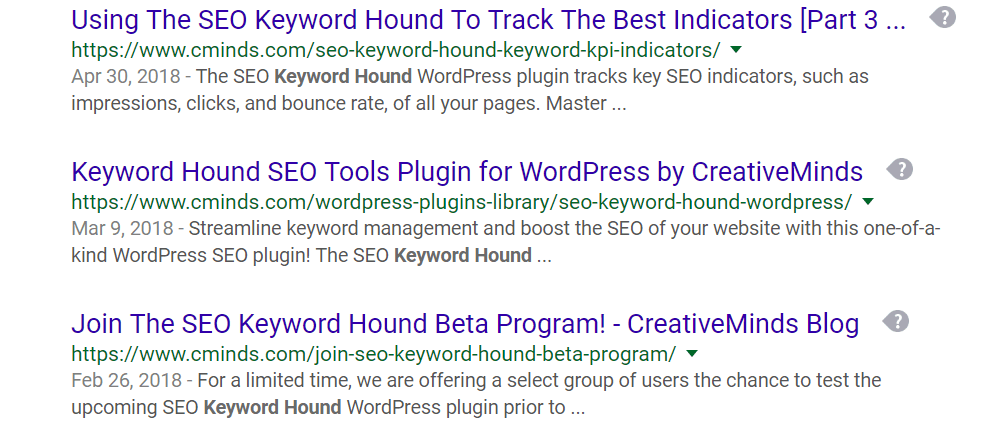To rank highly in search results you need to do SEO competitor analysis to find keywords. Enlisting the help of a WordPress SEO plugin can make it easier.

You should then edit your website according to the findings of the keywords research of your top competitors and make sure your website is SEO friendly.
The practice of online search-engine optimization (SEO) is—by its very nature—part of an intensely competitive arena. After all, there is only so much room available for top-ranking webpages to be displayed on search-engine pages, like Google.
May 2025 Offer – For a Limited Time Only:
Get WordPress SEO Keyword Hound Plugin for 25% off! Don’t miss out!
This means that (as with any contest) understanding the ins-and-outs of your biggest online rivals is necessary to succeed. This is also why conducting good SEO competitor analysis is so critically important.
If you find your competitors’ keywords and outrank them your website will win the competition over customers attention and get more impressions and traffic.

To assist WordPress users with their competitive SEO analysis efforts, we launched the SEO Keyword Hound plugin. This top WordPress plugin includes SEO competitor comparisons, along with helpful tools to find the best keywords that will advance your SEO strategy to generate organic traffic.
Today we’re covering exactly what SEO competitor analysis is, and some SEO effective strategies anyone can use to get a leg up on their competition.
To learn more about our SEO plugin and service offers, skip to the bottom of the post.
What is SEO Competitor Analysis?

Essentially, this analysis is another form of SEO keyword research. The difference from typical keyword research being a specific focus on what terms your competitors are currently targeting.
This is an important factor to consider, since the words and phrases that rival websites already rank highly for will be much harder to use well for your own website.
By conducting thorough SEO competitor analysis, website managers can learn what terms they should target and avoid. If they want to surpass another website’s current ranking, it’s also invaluable to understand how that website’s keyword strategy works.
To understand more about analyzing your competitors, you can find an in-depth resource on SEO competitor analysis from Moz here.
A Brief Overview of SEO Strategies

Of course, employing a powerful SEO strategy requires more than just finding and using keywords better than the rest. There’s plenty onsite SEO and offsite SEO practices that should coordinate to get your website ranking in the top results on search engines.
To Name Just a Few SEO Tricks:
- Providing Unique and High-Quality Content
- Ensuring Load Times are Fast
- Connecting Webpages with Internal and External Links
- Website Design with a Good User-Experience
- Webpages that are Mobile-Friendly
- Social Media and Offsite Content Marketing
Aside from keyword usage, these are the primary methods to improve the SEO friendliness and findability of websites.
Starting with Competitor Analysis in 3 Steps

To better understand and challenge your biggest competitors, here are the first and most important steps you need to take.
1. Identify Your Competition
When stepping up to the plate, it helps to know who you are battling against.
Depending on the products, services, or information your website specializes in, you’ll almost certainly find other websites providing similar offers. A great way to start locating these rival websites is to perform your own search queries. By entering the keywords you have in mind for your own website in Google and other search-engines, the results that pop-up will likely be competitors.
Complete a couple of these searches and take note of which websites show up repeatedly. These are the websites you’ll want to remember, and likely end up being the ones you’ll try to rank against.
2. Analyze their Keywords and Phrases
Once you’ve determined your competitors, it’s time to take a deeper inside look.
There are many different plugins for WordPress available on their marketplace to help you analyze this aspect of your competition. Of course, we’ve already mentioned our own Keyword Hound plugin and its unique competitor comparison features as well.
Studying the terms and phrases that your competition centers their keyword strategy around will help you form your own. If done correctly, this will allow you to find where other websites are lacking, and opportunities to raise yours against them.
3. Optimize your SEO Competitive Strategy

Once you are armed with effective keywords, either to challenge rival websites, or target terms they have ignored, it’s time to optimize your content.
The research process to get to this point is a little extensive, but it will effectively skyrocket the performance of your webpages. Employ the keywords you choose in your written content, page titles, alt-text, and everywhere else regarding your onsite SEO strategy.
With these steps completed, you should start noticing your website rising through the ranks of relevant search results before long. But keep in mind, good website SEO is a never-ending process. Resting on your laurels will only give other websites the opportunity to study and better compete with you.
Remember to always stay diligent!
SEO Keyword Hound plugin for WordPress websites
For WordPress users interested in boosting their SEO competitor analysis efforts, you can check out the SEO Keyword Hound plugin.
This plugin is designed for users of any experience level, and comes with included performance tracking to help pinpoint where your SEO tactics can be best improved. It also provides access to a complementary video course guide that teaches users how to apply the plugin—along with a comprehensive guide on performing effective keyword research and competitor analysis.


